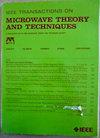A Synthesis Theory of Wideband Quasi-Elliptic Bandstop Filter With Back-to-Back Open-Ended Spanner Structure
IF 4.1
1区 工程技术
Q2 ENGINEERING, ELECTRICAL & ELECTRONIC
IEEE Transactions on Microwave Theory and Techniques
Pub Date : 2024-10-08
DOI:10.1109/TMTT.2024.3468915
引用次数: 0
Abstract
In this article, a quasi-elliptic wideband bandstop filter (BSF) is presented with the proposed synthesis theory. In order to analyze the novel mechanism of creating extra two reflection zeros (RZs) in back-to-back open-ended spanner structure, both without coupling structure (BSF I) and with coupling structure (BSF II) are analyzed and discussed in detail where BSF I consists of two open stubs, two cascaded transmission lines (TLs), and a stepped-impedance open stub, which is shunted in the center of the filter; by dividing the stepped-impedance open stub into two coupled line (CL) sections, BSF I becomes BSF II, which includes a back-to-back open-ended spanner structure. The proposed synthesis theory proves that BSFs I and II belong to the same theoretical quasi-elliptic response transfer function. Considering the urgent needs of design specifications for BSF, the proposed synthesis theory could directly design and control the stopband with equal-ripple performance, such as the fractional bandwidth of求助全文
约1分钟内获得全文
求助全文
来源期刊

IEEE Transactions on Microwave Theory and Techniques
工程技术-工程:电子与电气
CiteScore
8.60
自引率
18.60%
发文量
486
审稿时长
6 months
期刊介绍:
The IEEE Transactions on Microwave Theory and Techniques focuses on that part of engineering and theory associated with microwave/millimeter-wave components, devices, circuits, and systems involving the generation, modulation, demodulation, control, transmission, and detection of microwave signals. This includes scientific, technical, and industrial, activities. Microwave theory and techniques relates to electromagnetic waves usually in the frequency region between a few MHz and a THz; other spectral regions and wave types are included within the scope of the Society whenever basic microwave theory and techniques can yield useful results. Generally, this occurs in the theory of wave propagation in structures with dimensions comparable to a wavelength, and in the related techniques for analysis and design.
 求助内容:
求助内容: 应助结果提醒方式:
应助结果提醒方式:


